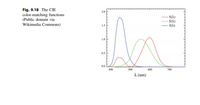
College Physics
11th Edition
ISBN: 9781305952300
Author: Raymond A. Serway, Chris Vuille
Publisher: Cengage Learning
expand_more
expand_more
format_list_bulleted
Concept explainers
Question
What are the wavelengths of the peaks in each color matching curve in
Fig. 9.18

Transcribed Image Text:**Figure 9.18**: The CIE color-matching functions (Public domain via Wikimedia Commons)
This figure illustrates the CIE color-matching functions, which are fundamental tools in the study of color vision. The graph consists of three curves representing the color-matching functions for the human eye:
1. **Red Curve (\( \overline{x}(\lambda) \))**: This curve is depicted in red and indicates the sensitivity of human vision to red light across different wavelengths. It peaks around the lower to mid-600 nm region, which corresponds to the red part of the visible spectrum.
2. **Green Curve (\( \overline{y}(\lambda) \))**: Shown in green, this function marks the sensitivity to green light, peaking around the mid-500 nm area, highlighting the central region of the visible spectrum.
3. **Blue Curve (\( \overline{z}(\lambda) \))**: This blue line shows the sensitivity to blue light, peaking towards the lower end of the spectrum around the 400-500 nm range.
The x-axis represents the wavelength in nanometers (nm), ranging from 400 nm to 700 nm, covering the visible spectrum. The y-axis indicates the relative sensitivity of the color-matching functions. Understanding these functions is essential for color science, allowing the precise depiction of colors in technologies such as monitors and printers.
Expert Solution
This question has been solved!
Explore an expertly crafted, step-by-step solution for a thorough understanding of key concepts.
This is a popular solution
Trending nowThis is a popular solution!
Step by stepSolved in 2 steps

Knowledge Booster
Learn more about
Need a deep-dive on the concept behind this application? Look no further. Learn more about this topic, physics and related others by exploring similar questions and additional content below.Similar questions
- Pls help ASAP. Pls show all workarrow_forwardPhotons from the Balmer series of hydrogen transitions are sent through a double slit. What must be the distance between the slits such that the lowest energy Balmer transition has a first-order maximum (maximum adjacent to the central maximum) at an angle of 2.00°? Express your answer in um. Type your answer... At what angle, in degrees, would the first maximum be for the fourth-lowest energy Balmer transition photon, when sent through the slits above? Type your answer... DOD Submitarrow_forwardAnswer all these questionsarrow_forward
- checking answer The spectrum of another astronomical object has a peak wavelength of 51 nanometers. What is the likely surface temperature of this object? Make that calculation, showing your workarrow_forwardQuestion 9 1 pts What is the total irradiance of a blackbody at the temperature of 200K. Provide you answer in units of W/m2.arrow_forwardModal Dispersion. Light of wavelength = 0.633 µm is transmitted through a mirror waveguide of mirror separation d = 10 μm and n = 1. Determine the number of TE and TM modes. Determine the group velocities of the fastest and the slowest mode. If a narrow pulse of light is carried by all modes for a distance 1 m in the waveguide, how much does the pulse spread as a result of the differences of the group velocities?arrow_forward
arrow_back_ios
arrow_forward_ios
Recommended textbooks for you
 College PhysicsPhysicsISBN:9781305952300Author:Raymond A. Serway, Chris VuillePublisher:Cengage Learning
College PhysicsPhysicsISBN:9781305952300Author:Raymond A. Serway, Chris VuillePublisher:Cengage Learning University Physics (14th Edition)PhysicsISBN:9780133969290Author:Hugh D. Young, Roger A. FreedmanPublisher:PEARSON
University Physics (14th Edition)PhysicsISBN:9780133969290Author:Hugh D. Young, Roger A. FreedmanPublisher:PEARSON Introduction To Quantum MechanicsPhysicsISBN:9781107189638Author:Griffiths, David J., Schroeter, Darrell F.Publisher:Cambridge University Press
Introduction To Quantum MechanicsPhysicsISBN:9781107189638Author:Griffiths, David J., Schroeter, Darrell F.Publisher:Cambridge University Press Physics for Scientists and EngineersPhysicsISBN:9781337553278Author:Raymond A. Serway, John W. JewettPublisher:Cengage Learning
Physics for Scientists and EngineersPhysicsISBN:9781337553278Author:Raymond A. Serway, John W. JewettPublisher:Cengage Learning Lecture- Tutorials for Introductory AstronomyPhysicsISBN:9780321820464Author:Edward E. Prather, Tim P. Slater, Jeff P. Adams, Gina BrissendenPublisher:Addison-Wesley
Lecture- Tutorials for Introductory AstronomyPhysicsISBN:9780321820464Author:Edward E. Prather, Tim P. Slater, Jeff P. Adams, Gina BrissendenPublisher:Addison-Wesley College Physics: A Strategic Approach (4th Editio...PhysicsISBN:9780134609034Author:Randall D. Knight (Professor Emeritus), Brian Jones, Stuart FieldPublisher:PEARSON
College Physics: A Strategic Approach (4th Editio...PhysicsISBN:9780134609034Author:Randall D. Knight (Professor Emeritus), Brian Jones, Stuart FieldPublisher:PEARSON

College Physics
Physics
ISBN:9781305952300
Author:Raymond A. Serway, Chris Vuille
Publisher:Cengage Learning

University Physics (14th Edition)
Physics
ISBN:9780133969290
Author:Hugh D. Young, Roger A. Freedman
Publisher:PEARSON

Introduction To Quantum Mechanics
Physics
ISBN:9781107189638
Author:Griffiths, David J., Schroeter, Darrell F.
Publisher:Cambridge University Press

Physics for Scientists and Engineers
Physics
ISBN:9781337553278
Author:Raymond A. Serway, John W. Jewett
Publisher:Cengage Learning

Lecture- Tutorials for Introductory Astronomy
Physics
ISBN:9780321820464
Author:Edward E. Prather, Tim P. Slater, Jeff P. Adams, Gina Brissenden
Publisher:Addison-Wesley

College Physics: A Strategic Approach (4th Editio...
Physics
ISBN:9780134609034
Author:Randall D. Knight (Professor Emeritus), Brian Jones, Stuart Field
Publisher:PEARSON